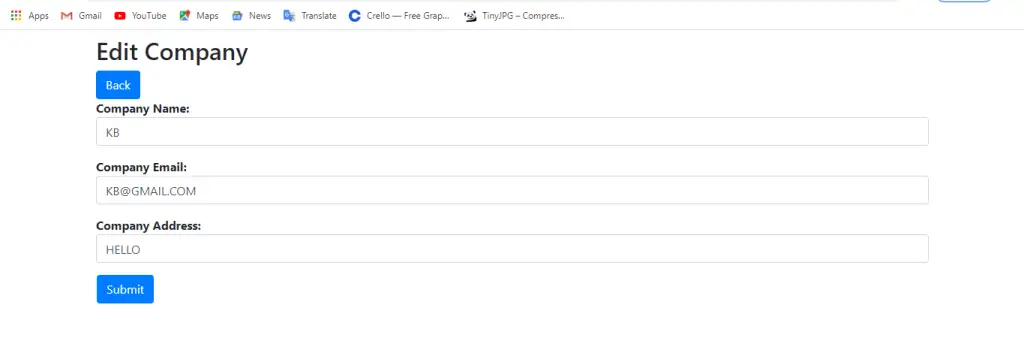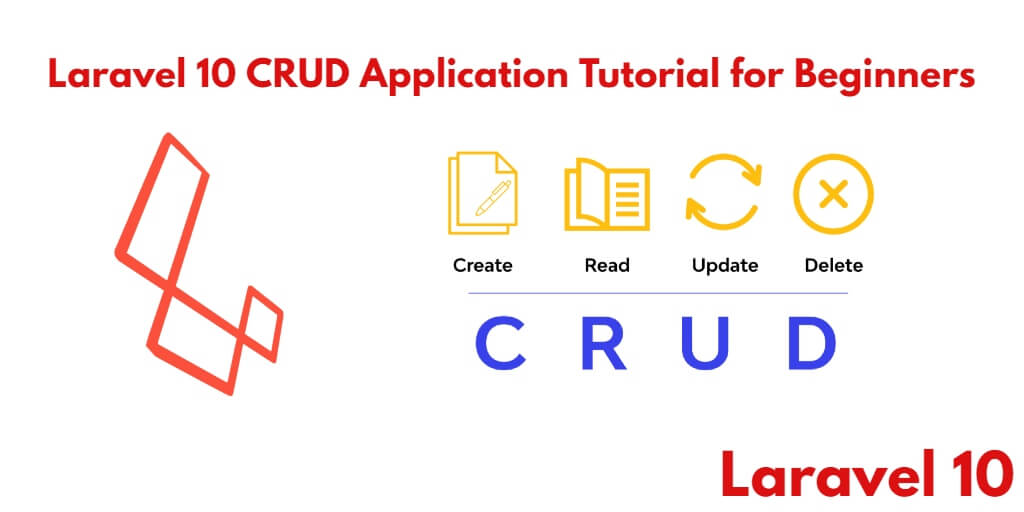If you are looking to create a simple CRUD (Create, Read, Update, Delete) application in Laravel, then this tutorial is designed for you. In this step-by-step guide, you will learn how to implement a CRUD functionality in your Laravel 10 web application.
The tutorial will cover the following key aspects:
- Setting up Laravel: You will learn how to install Laravel on your development environment and configure the necessary database connections.
- Database Migration: You will create a migration file to define the structure of your database table.
- Model Creation: You will generate a model class to interact with the corresponding database table.
- Routing: You will define the necessary routes in your application to handle CRUD operations.
- Controller Creation: You will create a controller to handle the logic for creating, reading, updating, and deleting records.
- Views: You will design the user interface by creating the necessary views to display the data and forms for creating and updating records.
- Form Handling: You will learn how to handle form submissions and perform the appropriate CRUD operations.
- Validation: You will implement validation rules to ensure data integrity and handle error messages.
Laravel 10 CRUD Operations Example Tutorial for Beginners
By using the following steps, you can learn how to create crud operation app in laravel 10:
- Step 1 – Setup New Laravel 10 App
- Step 2 – Setup Database with App
- Step 3 – Create Model & Migration
- Step 4 – Add Routes
- Step 5 – Create CRUD Operation Controller
- Step 6 – Create Blade Views File
- Make Directory Name Companies
- index.blade.php
- create.blade.php
- edit.blade.php
- Step 7 – Run Laravel CRUD App on Development Server
Step 1 – Setup New Laravel 10 App
First of all, start your terminal to download or install Laravel 10 new setup. Execute the following command into it to install new Laravel 10 app into your system:
composer create-project --prefer-dist laravel/laravel LaravelCRUD
Step 2 – Setup Database with App
Once you have installed laravel app on your server, now you need to configure your database with your apps.
So, visit your app root directory and find .env file. Then configure database details as follows:
DB_CONNECTION=mysql DB_HOST=127.0.0.1 DB_PORT=3306 DB_DATABASE=database-name DB_USERNAME=database-user-name DB_PASSWORD=database-password
Step 3 – Create Model & Migration
Open again your command prompt. And run the following command on it. To create model and migration file for form:
php artisan make:model Company -m
After that, open create_companies_table.php file inside LaravelCRUD/database/migrations/ directory. And the update the function up() with following code:
public function up()
{
Schema::create('companies', function (Blueprint $table) {
$table->id();
$table->string('name');
$table->string('email');
$table->string('address');
$table->timestamps();
});
}
Then, open again command prompt and run the following command to create tables into database:
php artisan migrate
Step 4 – Add Routes
Then create routes for laravel crud app. So, open web.php file from the routes directory of laravel CRUD app. And update the following routes into the web.php file:
use App\Http\Controllers\CompanyCRUDController;
Route::resource('companies', CompanyCRUDController::class);
Step 5 – Create CRUD Operation Controller
Create a controller by using the following command on the command prompt to create a controller file:
php artisan make:controller CompanyCRUDController
After that, visit at app/Http/controllers and open CompanyCRUDController.php file. And update the following code into it:
<?php
namespace App\Http\Controllers;
use App\Models\Company;
use Illuminate\Http\Request;
class CompanyCRUDController extends Controller
{
/**
* Display a listing of the resource.
*
* @return \Illuminate\Http\Response
*/
public function index()
{
$data['companies'] = Company::orderBy('id','desc')->paginate(5);
return view('companies.index', $data);
}
/**
* Show the form for creating a new resource.
*
* @return \Illuminate\Http\Response
*/
public function create()
{
return view('companies.create');
}
/**
* Store a newly created resource in storage.
*
* @param \Illuminate\Http\Request $request
* @return \Illuminate\Http\Response
*/
public function store(Request $request)
{
$request->validate([
'name' => 'required',
'email' => 'required',
'address' => 'required'
]);
$company = new Company;
$company->name = $request->name;
$company->email = $request->email;
$company->address = $request->address;
$company->save();
return redirect()->route('companies.index')
->with('success','Company has been created successfully.');
}
/**
* Display the specified resource.
*
* @param \App\company $company
* @return \Illuminate\Http\Response
*/
public function show(Company $company)
{
return view('companies.show',compact('company'));
}
/**
* Show the form for editing the specified resource.
*
* @param \App\Company $company
* @return \Illuminate\Http\Response
*/
public function edit(Company $company)
{
return view('companies.edit',compact('company'));
}
/**
* Update the specified resource in storage.
*
* @param \Illuminate\Http\Request $request
* @param \App\company $company
* @return \Illuminate\Http\Response
*/
public function update(Request $request, $id)
{
$request->validate([
'name' => 'required',
'email' => 'required',
'address' => 'required',
]);
$company = Company::find($id);
$company->name = $request->name;
$company->email = $request->email;
$company->address = $request->address;
$company->save();
return redirect()->route('companies.index')
->with('success','Company Has Been updated successfully');
}
/**
* Remove the specified resource from storage.
*
* @param \App\Company $company
* @return \Illuminate\Http\Response
*/
public function destroy(Company $company)
{
$company->delete();
return redirect()->route('companies.index')
->with('success','Company has been deleted successfully');
}
}
Step 6 – Create Blade Views File
Create the directory and some blade view, see the following:
- Make Directory Name Companies
- index.blade.php
- create.blade.php
- edit.blade.php
Create directory name companies inside resources/views directory.
Note that, create index.blade.php, create.blade.php and edit.blade inside companies directory. And update the following code into following files:
index.blade.php:
<!DOCTYPE html>
<html lang="en">
<head>
<meta charset="UTF-8">
<title>Laravel 10 CRUD Tutorial From Scratch</title>
<link rel="stylesheet" href="https://stackpath.bootstrapcdn.com/bootstrap/4.5.2/css/bootstrap.min.css" >
</head>
<body>
<div class="container mt-2">
<div class="row">
<div class="col-lg-12 margin-tb">
<div class="pull-left">
<h2>Laravel 10 CRUD Example Tutorial</h2>
</div>
<div class="pull-right mb-2">
<a class="btn btn-success" href="{{ route('companies.create') }}"> Create Company</a>
</div>
</div>
</div>
@if ($message = Session::get('success'))
<div class="alert alert-success">
<p>{{ $message }}</p>
</div>
@endif
<table class="table table-bordered">
<tr>
<th>S.No</th>
<th>Company Name</th>
<th>Company Email</th>
<th>Company Address</th>
<th width="280px">Action</th>
</tr>
@foreach ($companies as $company)
<tr>
<td>{{ $company->id }}</td>
<td>{{ $company->name }}</td>
<td>{{ $company->email }}</td>
<td>{{ $company->address }}</td>
<td>
<form action="{{ route('companies.destroy',$company->id) }}" method="Post">
<a class="btn btn-primary" href="{{ route('companies.edit',$company->id) }}">Edit</a>
@csrf
@method('DELETE')
<button type="submit" class="btn btn-danger">Delete</button>
</form>
</td>
</tr>
@endforeach
</table>
{!! $companies->links() !!}
</body>
</html>
create.blade.php:
<!DOCTYPE html>
<html lang="en">
<head>
<meta charset="UTF-8">
<title>Add Company Form - Laravel 10 CRUD</title>
<link rel="stylesheet" href="https://stackpath.bootstrapcdn.com/bootstrap/4.5.2/css/bootstrap.min.css" >
</head>
<body>
<div class="container mt-2">
<div class="row">
<div class="col-lg-12 margin-tb">
<div class="pull-left mb-2">
<h2>Add Company</h2>
</div>
<div class="pull-right">
<a class="btn btn-primary" href="{{ route('companies.index') }}"> Back</a>
</div>
</div>
</div>
@if(session('status'))
<div class="alert alert-success mb-1 mt-1">
{{ session('status') }}
</div>
@endif
<form action="{{ route('companies.store') }}" method="POST" enctype="multipart/form-data">
@csrf
<div class="row">
<div class="col-xs-12 col-sm-12 col-md-12">
<div class="form-group">
<strong>Company Name:</strong>
<input type="text" name="name" class="form-control" placeholder="Company Name">
@error('name')
<div class="alert alert-danger mt-1 mb-1">{{ $message }}</div>
@enderror
</div>
</div>
<div class="col-xs-12 col-sm-12 col-md-12">
<div class="form-group">
<strong>Company Email:</strong>
<input type="email" name="email" class="form-control" placeholder="Company Email">
@error('email')
<div class="alert alert-danger mt-1 mb-1">{{ $message }}</div>
@enderror
</div>
</div>
<div class="col-xs-12 col-sm-12 col-md-12">
<div class="form-group">
<strong>Company Address:</strong>
<input type="text" name="address" class="form-control" placeholder="Company Address">
@error('address')
<div class="alert alert-danger mt-1 mb-1">{{ $message }}</div>
@enderror
</div>
</div>
<button type="submit" class="btn btn-primary ml-3">Submit</button>
</div>
</form>
</body>
</html>
edit.blade.php:
<!DOCTYPE html>
<html lang="en">
<head>
<meta charset="UTF-8">
<title>Edit Company Form - Laravel 10 CRUD Tutorial</title>
<link rel="stylesheet" href="https://stackpath.bootstrapcdn.com/bootstrap/4.5.2/css/bootstrap.min.css" >
</head>
<body>
<div class="container mt-2">
<div class="row">
<div class="col-lg-12 margin-tb">
<div class="pull-left">
<h2>Edit Company</h2>
</div>
<div class="pull-right">
<a class="btn btn-primary" href="{{ route('companies.index') }}" enctype="multipart/form-data"> Back</a>
</div>
</div>
</div>
@if(session('status'))
<div class="alert alert-success mb-1 mt-1">
{{ session('status') }}
</div>
@endif
<form action="{{ route('companies.update',$company->id) }}" method="POST" enctype="multipart/form-data">
@csrf
@method('PUT')
<div class="row">
<div class="col-xs-12 col-sm-12 col-md-12">
<div class="form-group">
<strong>Company Name:</strong>
<input type="text" name="name" value="{{ $company->name }}" class="form-control" placeholder="Company name">
@error('name')
<div class="alert alert-danger mt-1 mb-1">{{ $message }}</div>
@enderror
</div>
</div>
<div class="col-xs-12 col-sm-12 col-md-12">
<div class="form-group">
<strong>Company Email:</strong>
<input type="email" name="email" class="form-control" placeholder="Company Email" value="{{ $company->email }}">
@error('email')
<div class="alert alert-danger mt-1 mb-1">{{ $message }}</div>
@enderror
</div>
</div>
<div class="col-xs-12 col-sm-12 col-md-12">
<div class="form-group">
<strong>Company Address:</strong>
<input type="text" name="address" value="{{ $company->address }}" class="form-control" placeholder="Company Address">
@error('address')
<div class="alert alert-danger mt-1 mb-1">{{ $message }}</div>
@enderror
</div>
</div>
<button type="submit" class="btn btn-primary ml-3">Submit</button>
</div>
</form>
</div>
</body>
</html>
If you submit the add or edit form blank. So the error message will be displayed with the help of the code given below:
@error('name')
<div class="alert alert-danger mt-1 mb-1">{{ $message }}</div>
@enderror
Step 7 – Run Development Server
Last step, open command prompt and run the following command to start developement server:
php artisan serve
Then open your browser and hit the following url on it:
http://127.0.0.1:8000/companies
The Laravel 10 company crud app will looks like following images:




very nice explained
nicee, thank you